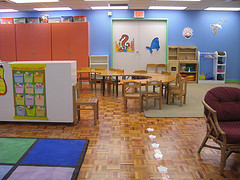 An elementary school in Indiana has started an interesting program. It’s called the Typical Peer Program. It puts a couple of students who do not have special needs into a classroom with students who have special needs. The “typical” peers model behavior, and everyone learns to accept others who are different from themselves.
An elementary school in Indiana has started an interesting program. It’s called the Typical Peer Program. It puts a couple of students who do not have special needs into a classroom with students who have special needs. The “typical” peers model behavior, and everyone learns to accept others who are different from themselves.
J.B. Stephens Elementary School, in Greenfield, Indiana, has started an innovative preschool program. It is called the Typical Peer Program. I have not heard of any other schools who are doing this.
The program is specifically directed to helping children who have special needs. At the start of a brand new school year, 2 Typical Peers are placed into a classroom of children who have special needs. They choose one boy and one girl per classroom of 10 children.
Students who are selected as Typical Peers who are younger (meaning age 3 or age 4) are placed into classes that meet twice a week. Typical Peers who are pre-kindergarten age (who will be eligible to start kindergarten in the next school year) are placed into classes that meet four times a week.
The Typical Peers are there to serve as good role models. They provide examples of social behavior and speech to their classmates who have special needs. The children who are acting as Typical Peers have no awareness of their purpose in the classroom. They also do not realize that they are learning how to accept those who are different from themselves.
Julie Rogers is a preschool teacher at J.B. Stephens Elementary School. She sees a noticeable difference in classrooms with typical peers. She said:
By the time they’re 4 going on 5, they have a lot of conversational skills and they’re really good talkers. They always have a comment, and some of our children have special needs. They learn how to answer questions and how to participate that way.
The principle of J.B. Stephens Elementary School is Candy Short. She has this to say about the Typical Peer program:
The most important reason to have a child in this program is the children who are typical peers will develop empathy for students who might have a different disability or a different way to learn.
I find this program to be fascinating. As a former teacher, and a former day care / preschool teacher, I realize that preschool is a good time to learn a lot of things, including how school “works”, what to do, what not to do, and how to get along with others. This seems like the perfect time to try a Typical Peer Program. It appears that everyone involved benefits from it.
Image by U.S. Embassy, Manila Philippines on Flickr

